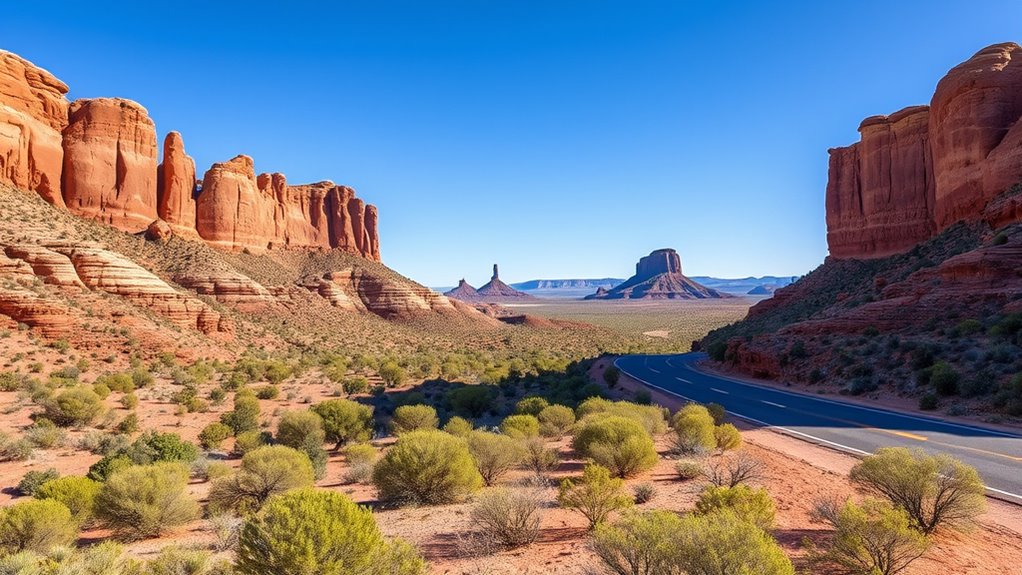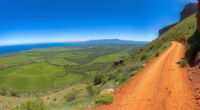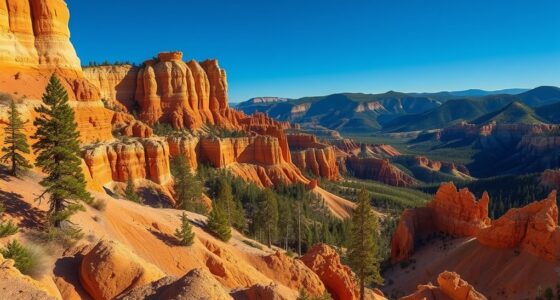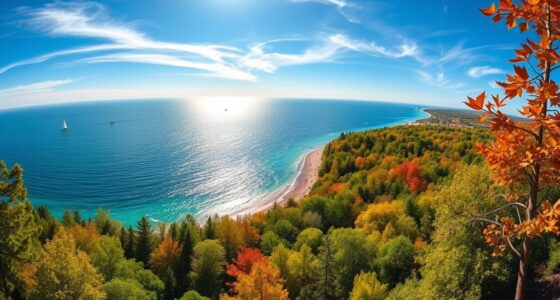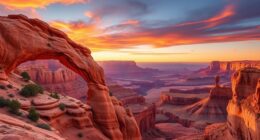Begin Arizona’s Ancient Cultures Scenic Drive to explore iconic archaeological sites like Montezuma Castle, Tuzigoot, and cliff dwellings. You’ll discover ancient petroglyphs, rock art, and living pueblos that reveal how early civilizations adapted to their environment. Stunning natural landmarks and scenic overlooks connect you to the land’s spiritual and cultural significance. Respectful engagement with sacred sites enhances your experience. Continue along the route to uncover the rich stories and traditions of Arizona’s indigenous peoples.
Key Takeaways
- Explore archaeological sites like Montezuma Castle and Tuzigoot for a glimpse into ancient architecture and cultural traditions.
- Drive through scenic overlooks that reveal Arizona’s rugged landscapes and the natural environment shaping indigenous history.
- Visit Native cultural centers and museums along the route to learn about indigenous crafts, stories, and spiritual practices.
- Discover natural landmarks such as mesas, mountains, and desert flora that hold cultural and spiritual significance.
- Engage respectfully with Native communities through guided tours, storytelling, and participating in traditional craft experiences.
The Origins of Arizona’s Indigenous Civilizations
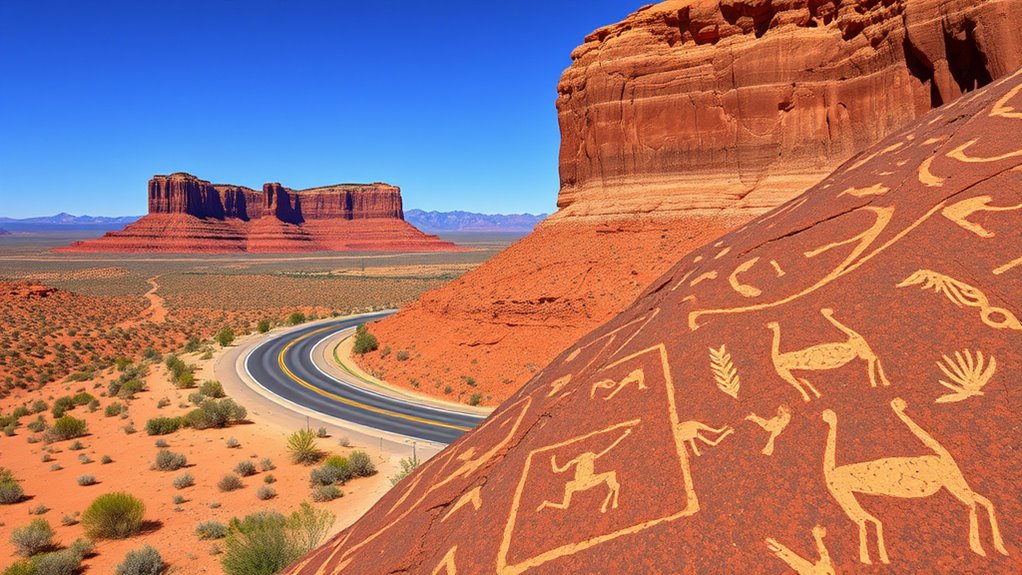
Arizona’s indigenous civilizations have roots that stretch back thousands of years, shaping the region’s rich cultural landscape. These early peoples engaged in ancient trade networks, exchanging goods like turquoise, pottery, and obsidian across vast distances. Such trade helped build connections among different groups and fostered cultural exchange. Ritual ceremonies played a essential role in their societies, serving as spiritual practices that honored deities, mark seasonal changes, or celebrate life events. You can imagine communities gathering for these sacred rituals, which reinforced social bonds and preserved traditions. Their craftsmanship and ceremonial practices reveal a deep spiritual connection to the land and a sophisticated understanding of their environment. These ancient trade routes and ritual ceremonies laid the foundation for the vibrant indigenous cultures that survive today.
Key Archaeological Sites Along the Route
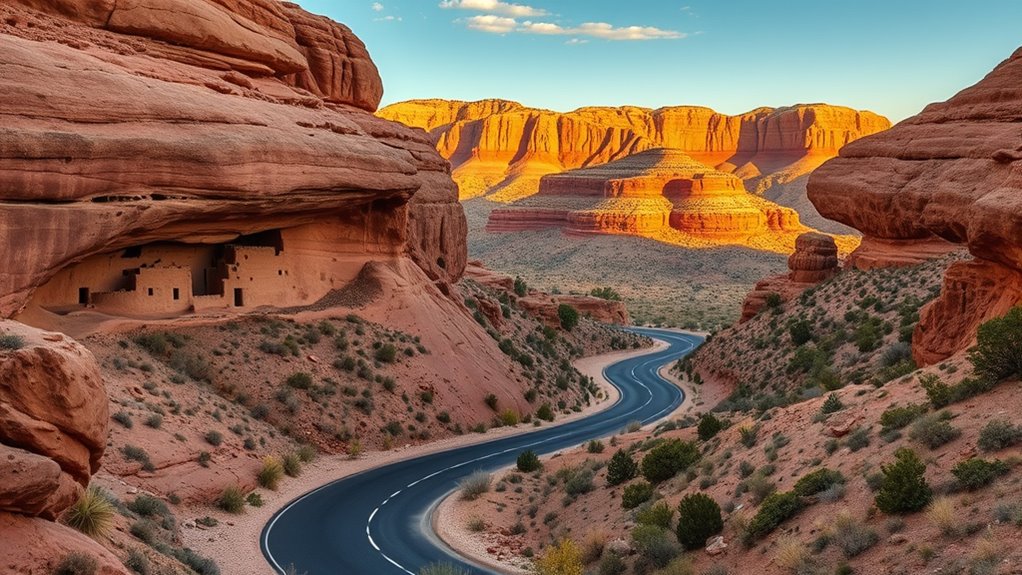
As you travel along this scenic route, you’ll encounter remarkable archaeological sites that reveal Arizona’s ancient history. Stops like Montezuma Castle Ruins and Tuzigoot National Monument showcase well-preserved cliff dwellings and pueblo structures. The Hohokam Pima Museum offers an engaging look at the culture and innovations of early inhabitants. Exploring the symbols and artifacts found at these sites can provide insights into the spiritual and cultural significance of the region’s history, including symbolism in art and culture. Understanding foraging techniques and the importance of sustainable practices can deepen your appreciation for how ancient peoples interacted with their environment. Developing leadership skills such as strategic planning and collaboration can enhance the preservation and interpretation of these cultural treasures. Additionally, cultivating a vibrational connection with the past can enrich your overall experience and understanding of these historical sites.
Montezuma Castle Ruins
Nestled high above the Verde Valley, the Montezuma Castle Ruins stand as a remarkable proof to the ingenuity of the ancient Sinagua people. This cliff dwelling, built into limestone ledges, reveals their advanced skills in architecture and resourcefulness. You’ll notice ancient pottery shards scattered around, offering clues to daily life and trade. The site was likely a center for sacred ceremonies, reflecting its spiritual significance. As you explore, imagine the Sinagua gathering here for rituals and social events. The towering structure’s strategic location provided protection and a commanding view of the valley. Learning about their cultural practices deepens your appreciation for this historical marvel. The site’s construction techniques showcase their mastery of using available natural materials to create durable and functional dwellings. Additionally, recent studies highlight how their innovative building methods contributed to the resilience of these structures over centuries. Exploring the site also reveals insights into their adaptation to environmental challenges, which was essential for their long-term survival. Understanding the trade networks of the Sinagua can further illuminate how they sustained their community over generations.
Tuzigoot National Monument
Tuzigoot National Monument rises prominently above the Verde River, offering a striking glimpse into the region’s ancient history. As you explore the site, you’ll see the well-preserved stone ruins of a pueblo built by the Sinagua people. This ancient community crafted beautiful pottery, some decorated with intricate patterns, revealing their artistic skills. You can imagine how they used these vessels for daily life and sacred rituals, connecting their spiritual beliefs to their community practices. The site’s layout hints at its importance as a cultural and ceremonial center. Walking through Tuzigoot, you get a sense of the people’s connection to the land and their spiritual traditions, which included sacred rituals that remain an essential part of their heritage.
Hohokam Pima Museum
Have you ever wondered how ancient peoples adapted to desert life? At the Hohokam Pima Museum, you’ll discover their ingenuity through stunning displays of Hohokam pottery and artifacts. This museum offers a glimpse into the daily lives and survival strategies of these early inhabitants. As you explore, you’ll learn about Pima storytelling traditions that preserve their history and culture. Additionally, understanding Glycolic Acid benefits can reveal how natural resources and innovations contributed to their adaptation strategies. You can also gain insights into desert survival techniques, which were essential for thriving in harsh environments. Exploring water conservation methods employed by these cultures further highlights their resourcefulness in arid conditions. Developing Cultural Intelligence helps us appreciate the significance of these adaptation methods within their cultural context. Moreover, examining how automation in business and technology have evolved underscores the importance of innovation in both past and present survival strategies. This museum connects you directly to the past, revealing how the Hohokam thrived in challenging environments and how Pima storytelling keeps their legacy alive today.
Exploring Ancient Cliff Dwellings and Pueblos

As you explore the ancient cliff dwellings and pueblos, you’ll notice how their architecture was perfectly suited to the rugged landscape. These structures served as both homes and ceremonial spaces, revealing the ingenuity of early inhabitants. Walking through these sites, you’ll get a firsthand look at how people adapted to their environment and built lasting communities.
Cliff Dwelling Architecture
Ancient cliff dwellings and pueblos stand as remarkable proofs to the ingenuity of Arizona’s early inhabitants. The cliff dwelling architecture showcases how these people adapted to their environment, building homes into natural alcoves and ledges. You’ll notice how the structures blend with the landscape, providing protection from weather and invaders. The use of mortar, stone, and wooden beams highlights their craftsmanship. These dwellings weren’t just homes—they were strategic, defensive sites that maximized available space. Exploring these ancient cliff dwellings reveals their sophisticated design, with multiple rooms, ladders, and storage areas. Their construction demonstrates advanced knowledge of engineering and resourcefulness, making them a fascinating glimpse into a resilient, resourceful civilization. Cliff dwelling architecture also reflects their ability to utilize natural formations for stability and defense. Additionally, studying these structures offers insights into their construction techniques, demonstrating a high level of ingenuity and adaptation. The integration of natural features into their building practices underscores their deep understanding of environmental adaptation. Such architectural mastery also indicates the importance of shelter and security in their daily lives, emphasizing how their environment shaped their innovations.
Pueblos and Living Spaces
Pueblos and living spaces in Arizona reveal how early inhabitants maximized their environment to create durable, efficient homes. These structures, often built into cliffs or on mesas, provided protection and shelter. Inside, you’ll find remnants of ancient pottery, which was used for storage and cooking, and evidence of traditional storytelling carved into the walls. The design of these pueblos reflects a deep understanding of the landscape, blending practicality with cultural expression. Additionally, the ancient pottery found in these sites offers valuable insights into their daily life and trade practices. Recognizing the importance of emotional support, many communities also incorporated social spaces within their dwellings to strengthen community bonds and promote well-being.
Deciphering Petroglyphs and Rock Art
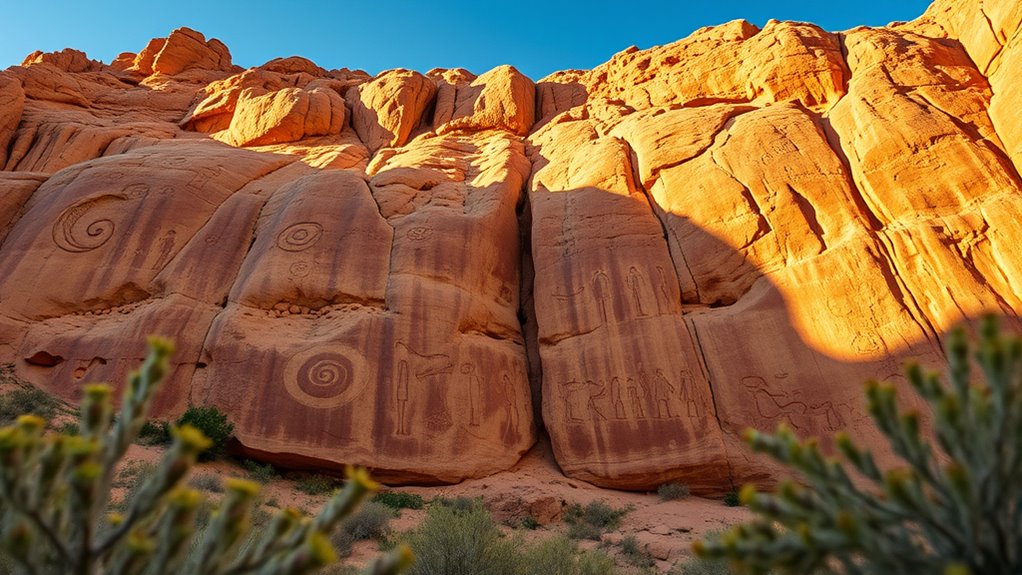
Deciphering petroglyphs and rock art offers a fascinating glimpse into the lives and beliefs of the region’s early inhabitants. These ancient images, etched into stone, reveal rock art symbolism that provides insight into spiritual practices, hunting, and community stories. To truly understand their significance, you need to contemplate petroglyph preservation, ensuring these images remain for future study. By analyzing shapes, patterns, and context, you can begin to interpret their meanings.
- Recognize common symbols like animals, human figures, and abstract shapes.
- Understand the cultural importance of specific motifs.
- Learn how natural elements influenced rock art design, recognizing how natural elements like ear wax odor can symbolize environmental connections.
- Appreciate ongoing efforts to conserve petroglyphs for future generations.
- Familiarize yourself with preservation methods and resources and tools available for preservation that can deepen your appreciation of these ancient artworks. Additionally, understanding the cultural context surrounding these carvings can greatly enhance interpretation and appreciation.
Natural Landmarks and Scenic Overlooks

Exploring the region’s natural landmarks and scenic overlooks allows you to fully appreciate the landscape that shaped early inhabitants’ lives and art. As you take in the sweeping mountain panoramas, you’ll see how these natural features create a dramatic backdrop for the area’s history. The desert flora, including cacti and wildflowers, thrives in this rugged landscape, adding bursts of color amidst the rocky terrain. From vantage points, you can observe the vastness of the desert floor stretching toward distant peaks, revealing the scale and beauty of Arizona’s natural environment. These landmarks not only offer stunning views but also serve as a reminder of the resilience of life in this arid landscape, connecting you to the land’s ancient story.
Cultural Significance of the Desert Landscape

The desert landscape of Arizona has long held deep cultural significance for the region’s Indigenous peoples. It’s more than just scenery; it’s a essential part of their identity and traditions. You can observe how desert flora, like cacti and wildflowers, symbolize resilience and adaptability. These plants often feature in cultural festivals, celebrating life and survival amid harsh conditions. The landscape also inspires storytelling, art, and spiritual practices that honor the land’s history. You might attend festivals that showcase traditional dances, music, and crafts rooted in desert life. Recognizing this connection helps you appreciate the desert’s cultural richness beyond its natural beauty. It’s a living heritage that continues to shape and inspire Indigenous communities today.
Tips for Visiting and Respecting Sacred Sites
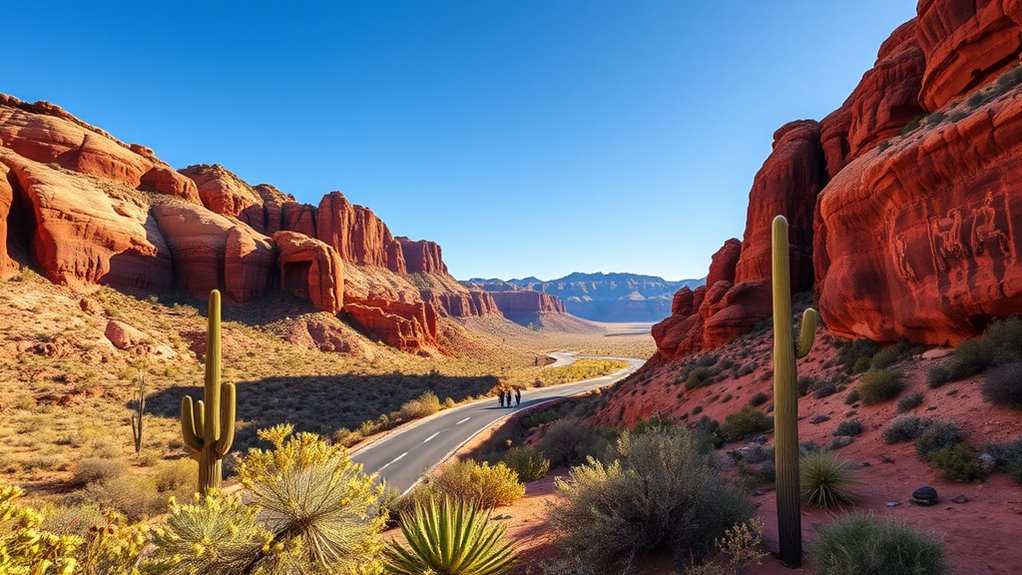
When visiting sacred sites in Arizona’s desert landscape, it’s essential to approach them with respect and mindfulness. Respectful visitation means staying on designated paths, avoiding loud noises, and refraining from touching or removing artifacts. Photography etiquette is vital—ask permission before taking photos and avoid capturing sensitive areas. To help you remember key tips, see the table below:
| Tip | Why it matters | How to practice it |
|---|---|---|
| Respect boundaries | Preserves cultural integrity | Follow signs and guides |
| Ask permission | Shows respect for traditions | Seek approval before photographing |
| Minimize disturbance | Protects sacred atmosphere | Keep noise low and avoid disruptive behavior |
| Stay on trails | Prevents damage to sites | Use marked paths |
| Leave no trace | Maintains site integrity | Pack out all trash |
Connecting With Arizona’S Living Native Communities

Connecting with Arizona’s living Native communities offers a meaningful way to deepen your understanding of the region’s rich cultural heritage. By engaging directly, you can experience authentic Native storytelling, which preserves history and traditions through oral narratives. Participating in traditional crafts workshops lets you learn skills like pottery, beadwork, or weaving, connecting you to centuries-old practices. Visiting Native-owned museums and cultural centers supports local artisans and offers insights into contemporary Native life. Attending community events or powwows provides an immersive experience in vibrant traditions and social bonds. These interactions foster respect and appreciation, giving you a genuine glimpse into the ongoing cultural significance of Arizona’s Native peoples.
- Native storytelling sessions
- Traditional craft demonstrations
- Cultural festivals and powwows
- Native-led tours and workshops
Frequently Asked Questions
Are There Guided Tours Available Along Arizona’S Ancient Cultures Scenic Drive?
You’ll find several guided tour options along Arizona’s Ancient Cultures Scenic Drive, offering engaging cultural interpretation programs. These tours often include knowledgeable guides who share insights into the region’s rich history, archaeology, and native traditions. Whether you prefer a leisurely drive with narration or a more interactive experience, participating in a guided tour enhances your understanding and appreciation of the area’s ancient cultures, making your visit more memorable and educational.
What Permits Are Required to Visit Certain Sacred or Restricted Sites?
Sure, managing the permitting process for restricted site access might seem like a simple formality, but it’s actually quite essential. You’ll need specific permits if you want to visit sacred or protected sites, respecting cultural sensitivities. These permits ensure that only authorized visitors access these areas, preserving their significance. So, don’t skip this step—obtaining the right permits helps you experience Arizona’s rich history responsibly and ethically.
How Can Visitors Respectfully Engage With Native Communities Along the Route?
You can respectfully engage with native communities along the route by practicing cultural sensitivity and asking permission before taking photos. Be mindful of local customs and avoid intrusive behavior. Show genuine respect by listening and learning from community members. When capturing photos, prioritize respectful photography, ensuring you don’t exploit or misrepresent their culture. Your respectful approach helps foster positive interactions and demonstrates your appreciation for their traditions and sacred sites.
Are There Recommended Times of Year to Avoid Extreme Weather Conditions?
Battling bad weather? To prevent extreme conditions, you should consider the best travel seasons carefully. Spring and fall usually bring mild, manageable weather, making your journey joyful and safe. Summer can be scorching, with soaring temperatures, while winter might bring icy inconveniences. Seasonal weather considerations are key; planning your trip during comfortable months ensures you enjoy Arizona’s scenery and cultural sites without weather worries.
What Safety Precautions Should Travelers Take When Exploring Remote Archaeological Areas?
When exploring remote archaeological areas, you should prioritize personal safety by staying on designated trails and informing someone of your plans. Carry enough water, wear appropriate clothing, and check weather conditions before you go. Be aware of wildlife, maintaining a respectful distance and avoiding feeding animals. Always carry a map, a fully charged phone, and a basic first aid kit to handle emergencies and guarantee a safe, enjoyable experience.
Conclusion
As you explore Arizona’s ancient cultures, you’ll uncover stories as vibrant as a painted sky at sunset. Respect these sacred sites like cherished chapters of history, and connect with living Native communities to deepen your understanding. This scenic drive is a journey through time, revealing the rich tapestry of Indigenous life. Just as the desert blooms with hidden treasures, your adventure will leave you inspired and in awe of Arizona’s timeless heritage.
